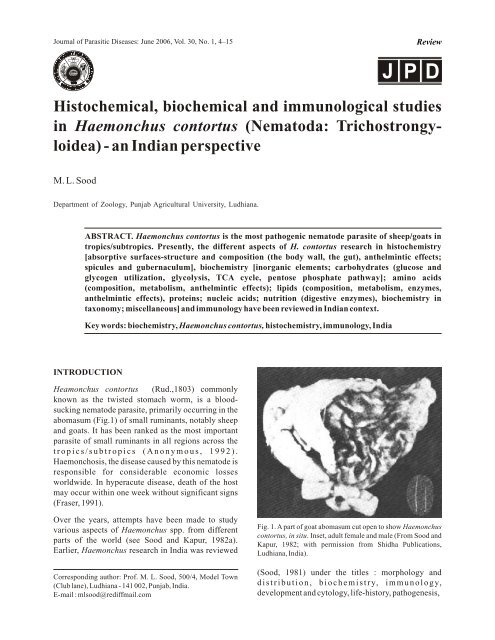Journal of Parasitic Diseases: June 2006, Vol. 30, No. 1, 4–15ReviewJ P DHistochemical, biochemical and immunological studiesin Haemonchus contortus (Nematoda: Trichostrongyloidea)- an <strong>Indian</strong> perspectiveM. L. SoodDepartment of Zoology, Punjab Agricultural University, Ludhiana.ABSTRACT. Haemonchus contortus is the most pathogenic nematode parasite of sheep/goats intropics/subtropics. Presently, the different aspects of H. contortus research in histochemistry[absorptive surfaces-structure and composition (the body wall, the gut), anthelmintic effects;spicules and gubernaculum], biochemistry [inorganic elements; carbohydrates (glucose andglycogen utilization, glycolysis, TCA cycle, pentose phosphate pathway]; amino acids(composition, metabolism, anthelmintic effects); lipids (composition, metabolism, enzymes,anthelmintic effects), proteins; nucleic acids; nutrition (digestive enzymes), biochemistry intaxonomy; miscellaneous] and immunology have been reviewed in <strong>Indian</strong> context.Key words: biochemistry, Haemonchus contortus, histochemistry, immunology, IndiaINTRODUCTIONHeamonchus contortus (Rud.,1803) commonlyknown as the twisted stomach worm, is a bloodsuckingnematode parasite, primarily occurring in theabomasum (Fig.1) of small ruminants, notably sheepand goats. It has been ranked as the most importantparasite of small ruminants in all regions across thetropics/subtropics (Anonymous, 1992).Haemonchosis, the disease caused by this nematode isresponsible <strong>for</strong> considerable economic lossesworldwide. In hyperacute disease, death of the hostmay occur within one week without significant signs(Fraser, 1991).Over the years, attempts have been made to studyvarious aspects of Haemonchus spp. from differentparts of the world (see Sood and Kapur, 1982a).Earlier, Haemonchus research in India was reviewedCorresponding author: Prof. M. L. Sood, 500/4, Model Town(Club lane), Ludhiana - 141 002, Punjab, India.E-mail : mlsood@rediffmail.comFig. 1. A part of goat abomasum cut open to show Haemonchuscontortus, in situ. Inset, adult female and male (From Sood andKapur, 1982; with permission from Shidha Publications,Ludhiana, India).(Sood, 1981) under the titles : morphology anddistribution, biochemistry, immunology,development and cytology, life-history, pathogenesis,
Haemonchus histochemistry, biochemistry and immunology5clinical symptoms, diagnosis, epidemiology, the cuticle (Sood and Kaur, 1977), has been welltreatment and prophylaxis. Subsequently, in a review documented (Sood and Kaur, 1976).on haemonchosis in India, Sood (2003) coveredepidemiology, pathology, diagnosis and control, <strong>The</strong> histochemical studies on the body wall of H.including resistant strains. Presently, the upcoming contortus (Sood and Kalra, 1977) have revealed thatareas of Haemonchus research, and the ones not fully the cuticle is mainly proteinaceous in nature. <strong>The</strong>covered in the above reviews have been taken up. lipids and PAS-positive materials are only present inHopefully, these three reviews, covering separately cortical layers. In addition, haemoglobin and acidthe various aspects, would provide an up-dated phosphatase (AcPase) are also present. Glycogen,consolidated account of 'Haemonchus to lipids, RNA, AcPase and alkaline phosphatasehaemonchosis' in India.(AkPase) have been reported in the hypodermis. <strong>The</strong>oval dense body is composed of keratinous andHISTOCHEMISTRYcollagenous proteins associated with acidmucopolysaccharides. Muscles carry a greaterHistochemical studies have been made on the concentration of glycogen granules andabsorptive surfaces (including in vitro anthelmintic phospholipids. <strong>The</strong> functional significance of theseeffects) and of the spicules and gubernaculum.components has been fully discussed.Absorptive surfaces<strong>The</strong> gut: Singh and Johl (2001) studied the structureParasitic nematodes have two absorptive surfaces- the of the <strong>for</strong>e-gut (stomodaeum). Histomorphology ofexternal surface or the body wall and the gut, though the intestine has also been studied (Johl, 2003). Soodlatter is the main functional unit from nutrition point of and Sehajpal (1978) made morphological,view. <strong>The</strong> body wall in nematodes is composed of the histochemical and biochemical studies. <strong>The</strong> intestinalcuticle, an underlying cell layer (hypodermis or epithelium (IE) is provided with a well-developedepidermis), and the longitudinally orientated somatic brush border (BB) which contains periodic acid-musculature (Wright, 1987). Nematode cuticle is one Schiff- positive mucoproteins. <strong>The</strong> IE stores glycogenof the most complex acellular structures synthesized and lipids. It stains diffusely <strong>for</strong> phospholipids andby a living organism. In order to understand the general proteins and also <strong>for</strong> terminal-NH 2 group. <strong>The</strong>2+ 3+transport of solutes in the body wall, experimental presence of Fe and Fe containing pigments anddetermination of diffusion coefficients of NaCl and activities of AcPase and AkPase, glucose-6-KCl in adult H. contortus at 298. 16 k has been made phosphatase (G-6-Pase) and 5'-nucleotidase have(Sood et al., 1999).been abserved in IE. Biochemically, pH optimum <strong>for</strong>intestinal AcPase has been found to be 4.8. BB shows<strong>The</strong> nematode gut consists of three parts, a muscular, positive reactions <strong>for</strong> Acpase and G-6-Pase, andcuticular lined pharynx (oesophagus), a relatively negative <strong>for</strong> AkPase and 5'-nucleotidase. Presence ofstraight intestine, whose wall is one cell thick and a enzymes in the BB is related to extracellular digestionrectum or cloaca, which like pharynx is lined by and absorption of nutrients.cuticle (Bird, 1971; Chitwood and Chitwood, 1974).Nematodes do not have a continuous muscle sheet Anthelmintic effectsaround the intestine and the pseudocoelomic fluid is inStudy of alterations induced in the absorptive surfacesdirect contact with the basement membrane. <strong>The</strong>(and neuromuscular system) of the parasites by the innematode intestine is, there<strong>for</strong>e, an ideal cellvitro incubations with the anthelmintic drugs is ofmonolayer to study the transport mechanisms, theprime importance, particularly in view of theonly diffusion barrier being the basement membranerepeatedly reported resistant strains of H. contortus.(Barrett, 1981).<strong>The</strong> mechanisms by which the drugs act on theseAbsorptive surfaces in H. contortus have been absorptive surfaces are quite obscure. During theirreviewed (Sood, 1999), under the titles: structure and absorption, anthelmintics are expected to induce somecomposition, immunology and anthelmintic effects. cellular and chemical changes in the absorptivesurfaces. Anthelmintics during their absorptionStructure and compositionaffect/and/or modify the enzyme activity and may alsoalter the normal metabolism of the absorptive<strong>The</strong> body wall: <strong>The</strong> morphology of the vulvarsurfaces.configurations in the female H. contortus, <strong>for</strong>med by










